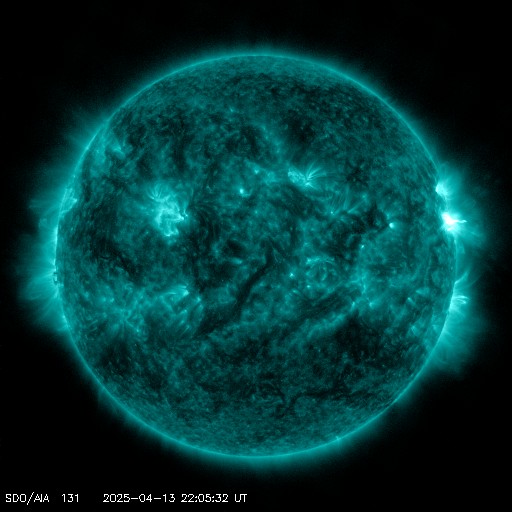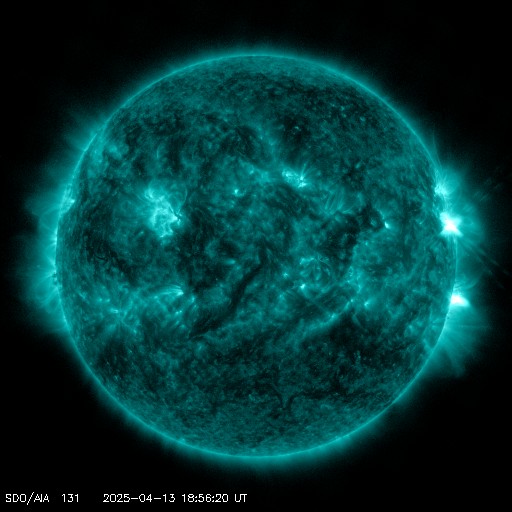Het archief bekijken van zondag 7 januari 2024
Dagelijks bulletin over zonne- en geomagnetische activiteit van het SIDC
Datum verslag: 2024 Jan 07 1252 UTC
SIDC Prognose
Zonnevlammen
M-class flares expected (probability >=50%)
Geomagnetisme
Active conditions expected (A>=20 or K=4)
Proton Flux monitor
Quiet
| 10cm flux | Ap | |
|---|---|---|
| 07 Jan 2024 | 144 | 008 |
| 08 Jan 2024 | 146 | 014 |
| 09 Jan 2024 | 150 | 014 |
Zonnevlekkengebieden en zonnevlammen
Solar flaring activity over the past 24 hours was at low levels. The largest flare was a C7.1-flare, with peak time 15:35 UTC on January 06, associated with NOAA AR 3538 (beta-gamma). There are currently 8 numbered active regions on the visible disk, in addition a new active region has rotated over the eastern limb and another active region has emerged near the centre of the solar disk both are yet unnumbered. NOAA AR 3536 (beta-gamma), NOAA AR 3538 (beta-gamma) and NOAA AR 3540 (beta-gamma-delta) are the most magnetically complex region on disk and have produced most of the flaring activity in the last 24 hours. NOAA AR 3534 (beta) has started to rotate over the west limb. All other regions were inactive and stable. The solar flaring activity is likely to be at moderate levels over the coming days with C-class flares expected and M-class flares possible.
Coronale massa uitstoten
A Coronal Mass Ejection (CME), was detected at 15:12 UTC on January 06, in LASCO C2 data. The CME is associated with a filament eruption observed in SDO/AIA 304 and 193 in the north-east quadrant of the Sun at 14:50 UTC on January 06. Further analysis is ongoing.
Coronale gaten
Two small high latitude positive polarity coronal holes are passing the central meridian. One in the northern half of the Sun and the other in the Southern half. No impact from these coronal holes is expected at Earth.
Zonnewind
Slow solar wind conditions were recorded over the past 24 hours. The solar wind speed as measured by ACE, appears to decline from around 340 km/s to around 310 km/s but there is a data gap in the ACE data between 21:40 UTC on January 06 and 08:36 UTC on January 07. The interplanetary magnetic field fluctuated between 2 nT and 3 nT, with the Bz reaching a minimum value of -3 nT. The phi-angle was mainly in the negative sector (directed towards the Sun) with periods in the positive sector. In the next 24 hours, the solar wind conditions are expected to become disturbed due to the arrival of a high-speed stream associated with a positive polarity coronal hole and the possible arrival of a CME from January 05.
Geomagnetisme
The geomagnetic conditions over the past 24 hours were globally and locally quiet (Kp 2 and K Bel 3). Quiet to unsettled conditions are expected in the next 24 hours.
Proton flux niveaus
The greater than 10 MeV proton flux was enhanced but below the 10 pfu threshold and continues to gently decline. The proton flux is expected to continue to decrease in the coming days.
Elektronenfluxen in geostationaire baan
The greater than 2 MeV GOES 16 electron flux was below the 1000 pfu threshold and is expected to remain so in the upcoming days. The 24h electron fluence was at nominal level and is expected to remain so in the next days.
Het geschatte internationale zonnevlekkengetal (ISN) van vandaag: 170, gebaseerd op 04 stations.Zon indexen voor 06 Jan 2024
| Wolfgetal Catania | /// |
| 10cm zonneflux | 159 |
| AK Chambon La Forêt | 005 |
| AK Wingst | 002 |
| Geschatte Ap | 002 |
| Geschat internationaal zonnevlekkengetal | 141 - Gebaseerd op 08 stations |
Overzicht opvallende gebeurtenissen
| Dag | Start | Max | Einde | Locatie | Sterkte | OP | 10cm | Catania/NOAA | Soorten radio-uitbarstingen | |
|---|---|---|---|---|---|---|---|---|---|---|
| Geen | ||||||||||
Aangeboden door het Solar Influences Data Analysis Center© - SIDC - Verwerkt door SpaceWeatherLive
Alle tijden in UTC
<< Keer terug naar de dagelijkse overview pagina
Op basis van de huidige parameters is er in de nabije toekomst een beperkte kans op poollicht op de volgende locaties van de hoge breedtegraad
TórshavnOulu, Rovaniemi
Reykjavik
Trondheim
Luleå
Laatste nieuws
Laatste forumberichten
Steun Poollicht.be!
Om ook bereikbaar te blijven bij grote poollichtkansen hebben we een zware server nodig die alle bezoekers aankan. Doneer en steun dit project zodat we online blijven en je geen enkele poollichtkans mist!

Laatste alerts
22:21 UTC - Zonnevlam
Matige M1.66 zonnevlam van zonnevlekkengebied 4055
22:03 UTC - Radio blackout
Kleine R1 radio blackout gedetecteerd (≥M1 - momenteel: M1.01)
20:48 UTC - Hemisferisch vermogen
Het OVATION-model voorspelt dat het hemisferisch vermogen 50GW zal bereiken om 21:39 UTC
19:09 UTC - Zonnevlam
Matige M3.24 zonnevlam van zonnevlekkengebied 4055
18:51 UTC - Radio blackout
Kleine R1 radio blackout gedetecteerd (≥M1 - momenteel: M1.07)
Ruimteweer feitjes
| Laatste X-klasse uitbarsting | 28/03/2025 | X1.1 |
| Laatste M-klasse uitbarsting | 13/04/2025 | M3.1 |
| Laatste geomagnetische storm | 06/04/2025 | Kp5 (G1) |
| Zonnevlekkenloze dagen | |
|---|---|
| Laatste zonnevlekkenloze dag | 08/06/2022 |
| Maandelijks gemiddeld zonnevlekkengetal | |
|---|---|
| maart 2025 | 134.2 -20.4 |
| april 2025 | 136.4 +2.2 |
| Afgelopen 30 dagen | 134.2 -8.9 |




